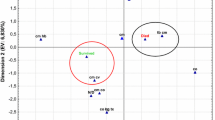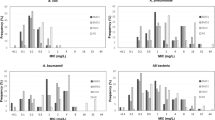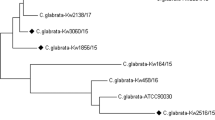Abstract
The emergence of antifungal resistance among Cryptococcus neoformans isolates is a matter of great concern. The Clinical and Laboratory Standards Institute (CLSI) broth microdilution reference method (BMD) for antifungal susceptibility testing of C. neoformans is tedious and time-consuming. Consequently, there is a greater need for a reproducible in vitro susceptibility testing method for use in clinical microbiology laboratories. By random amplified polymorphic DNA analysis, the 62 Indian clinical isolates were characterized as Cryptococcus neoformans var. grubii. We evaluated the susceptibilities of these isolates for amphotericin B (AMB) and fluconazole (FLC) by two commercial techniques, i.e., Vitek 2 and E-test against the CLSI M27-A3 BMD. The essential agreement (EA) between the Vitek 2 and E-test with the reference procedure for FLC was similar (82.2%). For AMB, EA of 92 and 76% was obtained with E-test and Vitek 2. Excellent categorical agreement (CA) (98.3% and 100% by Vitek 2 and E-test, respectively) was obtained for AMB. The CA for FLC was 81 and 77.4% by Vitek 2 and E-test. We conclude that both E-test and Vitek 2 system have acceptable levels of accuracy for susceptibility testing of both the drugs. Both of them could identify fluconazole-resistant strains. Vitek 2 could be used for testing susceptibility of voriconazole and 5-flucytosine also at the same time.
Similar content being viewed by others
References
Banerjee U, Datta K, Majumdar T, Gupta K. Cryptococcosis in India: the awakening of a giant? Med Mycol. 2001;39:51–67.
Shih CC, Chen YC, Chang SC, Luh KT, Hsieh WC. Cryptococcal meningitis in non-HIV-infected patients. Q J Med. 2000;93:245–51.
Antinori S, Ridolfo A, Fasan M, Magni C, Galimberti L, Milazzo L, Sollima S, Adorni F, Giuliani G, Galli M, Corbellino M, Parravicini C. AIDS-associated cryptococcosis: a comparison of epidemiology, clinical features and outcome in the pre- and post-HAART eras. Experience of a single centre in Italy. 2009. HIV Med. 2009;10:6–11.
Friese G, Discher T, Fussle R, Schmalreck A, Lohmeyer J. Development of azole resistance during fluconazole maintenance therapy for AIDS associated cryptococcal disease. AIDS. 2001;15:2344–5.
Mondon P, Petter R, Amalfitano G, Luzzati R, Concia E, Polacheck I, Kwon-Chung KJ. Heteroresistance to fluconazole and voriconazole in Cryptococcus neoformans. Antimicrob Agents Chemother. 1999;49:1856–61.
Silva PR, Rabelo RA, Terra AP, Teixeira DN. Susceptibility to antifungal agents among Cryptococcus neoformans varieties isolated from patients at a university hospital. Rev Soc Bras Med Trop. 2008;41:158–62.
Cuenca-Estrella M, Gomez-Lopez A, Alastruey-Izquierdo A, Bernal-Martinez L, Cuesta I, Buitrago MJ, Rodriguez-Tudela JL. Comparison of the Vitek 2 Antifungal susceptibility system with the Clinical and Laboratory Standards Institute (CLSI) and European Committee on Antimicrobial susceptibility testing (EUCAST) broth microdilution reference methods and with the sensititre yeast one and Etest techniques for in vitro detection of antifungal resistance in yeast isolates. J Clin Microbiol. 2010;48:1782–6.
Chryssanthou E, Grönfors C, Khanna N. Comparison of broth macrodilution, broth microdilution and E-test susceptibility tests of Cryptococcus neoformans for fluconazole. Mycoses. 1997;40:423–7.
Bourgeois N, Dehandschoewercker L, Bertout S, et al. Antifungal susceptibility of 205 Candida spp. isolated primarily during invasive Candidiasis and comparison of the Vitek 2 system with the CLSI broth microdilution and Etest methods. J Clin Microbiol. 2010;48:154–61.
González MT, González A, Cantón E, Aller AI, Romero A, Pemán J, Quindós G, Martín-Mazuelos E. Evaluation of the VITEK 2 system to test the susceptibility of Candida spp., Trichosporon asahii and Cryptococcus neoformans to amphotericin B, flucytosine, fluconazole and voriconazole: a comparison with the M27–A3 reference method. Med Mycol. 2010;48:710–9.
Kwon-Chung KJ, Polacheck I, Popkin TJ. Melanin lacking mutants of Cryptococcus neoformans and their virulence for mice. J Bacteriol. 1982;150:1414–21.
Franzot SP, Hamdan JS, Currie BP, Casadevall A. Molecular epidemiology of Cryptococcus neoformans in Brazil and the United States evidence for both local genetic difference and a global clonal population structure. J Clin Microbiol. 1997;35:2243–51.
Meyer W, Mitchell TG, Freedman EZ, Vilgalys R. Hybridization probes for conventional DNA fingerprinting used as single primers in the polymerase chain reaction to distinguish strains of Cryptococcus neoformans. J Clin Microbiol. 1993;31:2274–80.
Clinical and Laboratory Standards Institute. Reference method for broth dilution antifungal susceptibility testing of yeasts. Approved Standard third edition, M27-A3.Wayne, PA; 2008.
Lozano-Chiu M, Paetznick VL, Ghannoum MA, Rex JH. Detection of resistance to amphotericin B among Cryptococcus neoformans clinical isolates: performances of three different media assessed by using E-test and National Committee for Clinical Laboratory Standards M27-A methodologies. J Clin Microbiol. 1998;36:2817–22.
Aller AI, Martín-Mazuelos E, Gutiérrez MJ, Bernal S, Chávez M, Recio FJ. Comparison of the Etest and microdilution method for antifungal susceptibility testing of Cryptococcus neoformans to four antifungal agents. J Antimicrob Chemother. 2000;46:997–1000.
Jain N, Wickes BL, Keller SM, Casadevall A, Jain P, Ragan MA, Banerjee U, Fries BC. Molecular epidemiology of clinical Cryptococcus neoformans strains from India. J Clin Microbiol. 2005;43:5733–42.
Mitchell TG, Perfect JR. Cryptococcosis in the era of AIDS-100 years after the discovery of Cryptococcus neoformans. Clin Microbiol Rev. 1995;8:515–48.
Clark RA, Greer DL, Atkinson W, Valainis GT, Hyslop N. Spectrum of Cryptococcus neoformans infection in 68 patients infected with human immunodeficiency virus. Rev Infect Dis. 1990;12:768–77.
Brandt ME, Pfaller MA, Hajjeh RA, Hajjeh RA, Hamill RJ, Pappas PG, Reingold AL, et al. Trends in antifungal drug susceptibility of Cryptococcus neoformans isolates in the United States: 1992 to 1994 and 1996 to 1998. Antimicrob Agents Chemother. 2001;45:3065–9.
Brandt ME, Pfaller MA, Hajjeh RA, Graviss EA, Rees J, Spitzer ED, Pinner RW, Mayer LW, Cryptococcal Disease Active Surveillance Group. Molecular subtypes and antifungal susceptibilities of serial Cryptococcus neoformans isolates in human immunodeficiency virus associated Cryptococcosis. J Infect Dis. 1996;174:812–20.
Spitzer ED, Spitzer SG, Freundlich LF, Casadevall A. Persistence of initial infection in recurrent Cryptococcus neoformans meningitis. Lancet. 1993;341:595–6.
Pfaller M, Zhang J, Messer S, Tumberland M, Mbidde E, Jessup C, Ghannoum M. Molecular epidemiology and antifungal susceptibility of Cryptococcus neoformans isolates from Ugandan AIDS patients. Diagn Microbiol Infect Dis. 1998;32:191–9.
Franzot SP, Hamdan JS. In vitro susceptibilities of clinical and environmental isolates of Cryptococcus neoformans to five antifungal drugs. Antimicrob Agents Chemother. 1996;40:822–4.
Klepser ME, Pfaller MA. Variation in electrophoretic karyotype and antifungal susceptibility of clinical isolates of Cryptococcus neoformans at a university affiliated teaching hospital from 1987 to 1994. J Clin Microbiol. 1998;36:3653–6.
Capoor MR, Mandal P, Deb M, Aggarwal P, Banerjee U. Current scenario of cryptococcosis and antifungal susceptibility pattern in India: a cause for reappraisal. Mycoses. 2008;51:258–65.
Datta K, Jain N, Sethi S, Rattan A, Casadevall A, Banerjee U. Fluconazole and itraconazole susceptibility of clinical isolates of Cryptococcus neoformans at a tertiary care centre in India: a need for care. J Antimicrob Chemother. 2003;52:683–6.
Colombo AL, Barchiesi F, McGough DA, Rinaldi MG. Comparison of E-test and National Committee for Clinical Laboratory Standards broth macrodilution method for azole antifungal susceptibility testing. J Clin Microbiol. 1995;33:535–40.
Espinel-Ingroff A, Pfaller M, Erwin ME, Jones RN. Interlaboratory evaluation of E-test method for testing antifungal susceptibilities of pathogenic yeasts to five antifungal agents by using Casitone agar and solidified RPMI 1640 medium with 2% glucose. J Clin Microbiol. 1996;34:848–52.
Dias AL, Matsumoto FE, Melhem MS, da Silva EG, Auler ME, de Siqueira AM, Paula CR. Comparative analysis of Etest and broth microdilution method (AFST-EUCAST) for trends in antifungal drug susceptibility testing of Brazilian Cryptococcus neoformans isolates. J Med Microbiol. 2006;55:1693–9.
Author information
Authors and Affiliations
Corresponding author
Rights and permissions
About this article
Cite this article
Tewari, A., Behera, B., Mathur, P. et al. Comparative Analysis of the Vitek 2 Antifungal Susceptibility System and E-test with the CLSI M27-A3 Broth Microdilution Method for Susceptibility Testing of Indian Clinical Isolates of Cryptococcus neoformans . Mycopathologia 173, 427–433 (2012). https://doi.org/10.1007/s11046-012-9528-9
Received:
Accepted:
Published:
Issue Date:
DOI: https://doi.org/10.1007/s11046-012-9528-9




